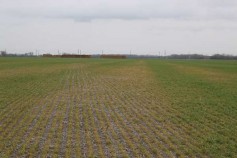Breadcrumb
- Home
- Recent news stories
- Cold Weather Info and Best Management Practices from KSRE Agronomy

Yellow portions of the field correspond to greater residue left by the combine at soybean harvest and resulted in poorer seed-soil contact at wheat planting. Photo provided by Romulo Lollato, K-State Research and Extension.
Mother Nature has decided to swing around from season to season with no rhyme or reason over the last few weeks, and that ever-changing weather pattern may have some effects on Kansas wheat. K-State Research and Extension Agronomy’s E-Update has the latest information on the rapidly changing season, management adjustments for late-planted wheat and replanting considerations to help your 2020 harvest get off on the right foot.
According to the E-Update, the sudden, sharp drop in temperatures across Kansas observed in late-October 2019 could have varying consequences to the wheat crop, ranging from no impact to some injury in particular fields. Average temperatures dropped from around mid-60 to 70 degrees F on October 26 to approximately -1 to 14 degrees F on October 31.
The actual consequences of this temperature drop should be field-specific, depending on the region within the state and several other factors. The snowfall amount and moisture level in the topsoil will be important to help buffer possible injuries resulting from cold temperatures. When more than 2-3 inches of snow is on the soil surface, it helps protect the wheat crop by buffering temperature changes in the surface soil. Topsoil moisture is very variable across the state, with topsoil’s percent of saturation ranging from 17% in Garden City to 93-98% in southeast Kansas. Where the soil is dry, it will result in lower thermal buffer capacity, compared to a moist soil, and winter injury might be more pronounced. While the average soil temperatures followed a similar trend compared to air temperatures, the minimum 2-inch soil temperatures measured across the state was about 26 degrees F in parts of southwest Kansas. While these soil temperatures are relatively low, they could help buffer any negative effects of the sharp air temperature drop.
Producers are encouraged to start checking for possible injury on lower portions of the fields and especially in no-till fields with heavy residue in the near future, but no immediate damage will be apparent. The cold temperatures also will be more likely to cause injury to wheat if the plants were showing drought stress symptoms as dry soils will get colder more easily than wet soils. Additionally, the drier and looser the seedbed soil is, the greater the potential for the plant to be exposed to cold temperatures resulting in injury. Meanwhile, firmer and moister soils should help to minimize rapid fluctuations in soil temperatures allowing the wheat to better withstand cold temperatures.
On the other hand, if you have experienced a delay in planting this year there are management adjustments that can be made to try to compensate for the consequences of late planting. These adjustments include increasing seeding rates, maintaining the optimal planting depth (1 to 1.5 inches deep), placing starter phosphorus fertilizer with the seed, using fungicide seed treatment or planting certified seed and variety selection.
As wheat growers evaluate their wheat stand, some may be considering replanting fields yet this fall. In some cases, the emergence might be spotty, with lower areas in the field presenting the worst stand establishment. These low-lying areas are typically not as well-drained, which creates conditions that cause poor emergence. Other fields might have experienced heavy rains after planting, causing soil crusting and preventing the coleoptile from breaking through the soil surface. If the coleoptile stays underground for more than a week or so, it will start losing viability. At that point, the producer will need to consider replanting.
When deciding whether to replant wheat fields it is helpful to consider these factors: stand uniformity, percent stand compared to the target stand, replanting date, weed control and insurance cutoff date.
Please visit the K-State Research and Extension Agronomy E-Updates to learn about these topics and more.
